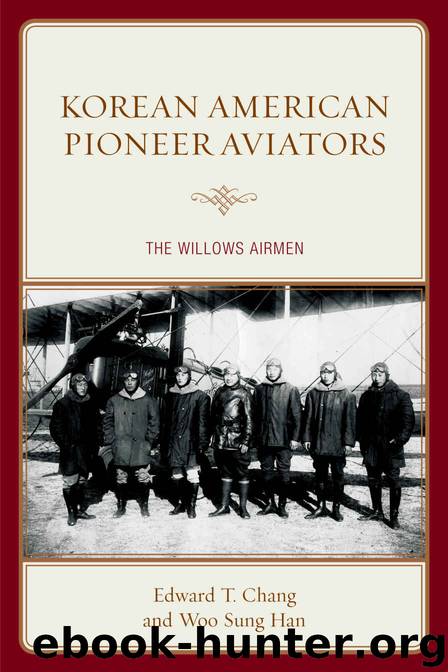Korean American Pioneer Aviators by Chang Edward T. & Han Woo Sung

Author:Chang, Edward T. & Han, Woo Sung
Language: eng
Format: epub
Tags: undefined
ISBN: undefined
Publisher: Lexington Books
Published: 2015-04-28T16:00:00+00:00
7. The New Korea, April 9, 1920.
Chapter 3
Korean and American Aviation History
What is the significance of the establishment of the Willows Korean Aviation School/Corps by the Korean Provisional Government in the context of world-wide conditions? The United States invented the airplane, is the leading nation in aerospace engineering, and possesses the world’s strongest air force today. In 1783, France opened the door for humanity’s desire to fly when it successfully flew a hydrogen air balloon. One hundred twenty years later, the Wright brothers dreamt of creating a powered and controlled flying machine. The Wright brothers realized that dream on December 17, 1903, when they successfully built and flew the first airplane; on that day, modern aviation was born. Throwing open the doors for travel, communication, and international commerce, the world was reconfigured into a global community.[1]
In July 1909, the Wright brothers completed flight demonstrations for the U.S. Army and met its requirements; planes had to be two-seaters, able to fly with a passenger for an hour at an average speed of 40 miles per hour (64 km/h), and land undamaged.
The U.S. Army began to explore the possibility of using airplanes as a military tactic by purchasing the Army Aeroplane No. 1 from the Wright brothers in 1909. Although Eugene Fly succeeded in flying an airplane off the U.S. warship Birmingham, allowing the possibility of the aircraft carrier, the U.S. military was still unsure of using aircraft for military purposes. However, in 1913, one year before the outbreak of World War I, the U.S. Congress passed a resolution requiring an aviation unit in the Army, and it began to build up its aviation corps.
The U.S. Army aviation unit possessed less than one thousand airplanes during World War I, and the unit was placed under the direct command of the Signal Corps. While air power was not highly regarded the way it is today, World War I increased awareness and the importance of having air power. For example, France requested from the United States 4,500 aircraft, 5,000 pilots, and 50,000 mechanics within a year. Although aircraft were used for military purposes during World War I, it was dangerous to fly because airplanes were not highly developed. Even practicing was unsafe, making combat flights during World War I extremely difficult.
For example, in the British Army, one out of ninety trainee pilots was killed during the beginner’s course training, one out of fifty during the intermediate course training, and one out of nine pilots died during the advanced course training. In this context, it was truly amazing that so many young Korean men volunteered to enroll at the Willows Korean Aviation School/Corps despite the high risk; they were still willing to sacrifice themselves for the independence of Korea.
In 1918, the U.S. Army detached its air unit from the Signal Corps and established a separate aviation corps as air power became more important during World War I. Despite the effectiveness of air power during World War I, major super powers still continued to debate what to do with aviation units until the early 1920s.
Download
This site does not store any files on its server. We only index and link to content provided by other sites. Please contact the content providers to delete copyright contents if any and email us, we'll remove relevant links or contents immediately.
| Automotive | Engineering |
| Transportation |
Small Unmanned Fixed-wing Aircraft Design by Andrew J. Keane Andras Sobester James P. Scanlan & András Sóbester & James P. Scanlan(32570)
Navigation and Map Reading by K Andrew(4884)
Endurance: Shackleton's Incredible Voyage by Alfred Lansing(4496)
And the Band Played On by Randy Shilts(2007)
Wild Ride by Adam Lashinsky(1863)
The Box by Marc Levinson(1856)
Top 10 Prague (EYEWITNESS TOP 10 TRAVEL GUIDES) by DK(1845)
The Race for Hitler's X-Planes: Britain's 1945 Mission to Capture Secret Luftwaffe Technology by John Christopher(1738)
The One Percenter Encyclopedia by Bill Hayes(1713)
Trans-Siberian Railway by Lonely Planet(1625)
Girls Auto Clinic Glove Box Guide by Patrice Banks(1615)
Looking for a Ship by John McPhee(1569)
Batavia's Graveyard by Mike Dash(1545)
TWA 800 by Jack Cashill(1519)
Fighting Hitler's Jets: The Extraordinary Story of the American Airmen Who Beat the Luftwaffe and Defeated Nazi Germany by Robert F. Dorr(1511)
Troubleshooting and Repair of Diesel Engines by Paul Dempsey(1495)
Good with Words by Patrick Barry(1493)
Bligh by Rob Mundle(1483)
Ticket to Ride by Tom Chesshyre(1476)
